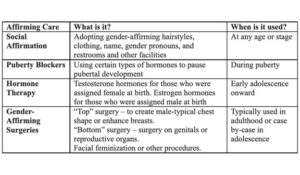The following Opinion Editorial appeared in National Review November 20, 2022
Biden’s HHS will wield ‘one of the government’s most powerful tools’ to advance a radical agenda on abortion and transgenderism.
After the midterm elections, President Biden promised that “nothing will change.” With Congress remaining gridlocked, he will rule by executive order and regulation. One of his more significant actions will likely consist of making final a regulation his Department of Health and Human Services proposed on August 4. Innocuously titled “Nondiscrimination in Health Programs and Activities,” it will impose a series of sexual health-plan-coverage and hospital-performance mandates that will constitute a cultural earthquake for hospitals, doctors, employers, and families.
Through this rule, HHS is leveraging Section 1557 of the Affordable Care Act to transform it into a new super sexual-rights statute. When HHS makes its 1557 Rule final, it, acting in concert with the EEOC, will mandate that physicians and hospitals perform chemical and surgical abortions and deliver an ever-expanding list of services called “gender-affirming care” (GAC) for “non-binary persons.” They will also require employers, insurers, and third-party administrators to cover such services in their health plans. The gender-nonconforming persons will include not only those identifying as transgender but also those identifying as eunuchs. HHS will partially delegate its future rulemaking in this area to radicalized medical societies, including the American Academy of Pediatricians, the Endocrine Society, the American Academy for Child and Adolescent Psychiatry, and, especially, the World Professional Association for Transgender Health, so that their standards of care will ipso facto have the force of law. This is why HHS says that “Section 1557 . . . is one of the government’s most powerful tools” to advance its sexual-rights agenda.
There was a prequel to HHS’s announcement of its new rule on March 31, which has been designated International Transgender Visibility Day. By that date, HHS and two sister agencies had published statements previewing the new regulation: HHS’s Notice and Guidance on Gender Affirming Care, the Office of the Assistant Secretary of Health’s Gender-Affirming Care and Young People, and National Child Traumatic Stress Network’s Gender-Affirming Care Is Trauma-Informed Care. These statements introduced a new term, “gender-affirming care” in place of what HHS previously called “gender transition services.” “Affirming care” sounds better, and it means more. It includes not only cross-sex hormones, breast removal, and genital-mutilating surgeries, but also puberty blockers, gender-conforming cosmetic surgeries, social affirmation, access to single-sex spaces and programs, examinations of conscience, and reform of personal biases.
The second aspect of the prequel was the White House’s and HHS’s response to Dobbs’s reversal of Roe v. Wade. On July 8, President Biden issued an executive order stating that Dobbs has had “devastating implications for women’s health.” The EO then defined “reproductive healthcare services” as including “termination of pregnancy.” It also ordered HHS to promptly report on how “to protect and expand access to abortion care, including medication abortion.” Finally, it ordered HHS to identify how the Emergency Medical Treatment and Labor Act (EMTALA) might advance federal abortion rights.
HHS swung into action. Three days later, its Center for Medicare and Medicaid Services issued its Reinforcement of EMTALA Obligations Specific to Patients Who Are Pregnant or Are Experiencing Pregnancy Loss. This notice advised hospitals and physicians that EMTALA required them to “stabilize” “people in labor” by performing emergency abortions. It pointedly stated that “when a state law prohibits abortion, . . . that state law is preempted.” It also declared that EMTALA’s anti-retaliation provision would protect physicians from discipline by their Catholic-hospital employers if they performed abortions in defiance of the Catholic Church’s Ethical and Religious Directives.
As the U.S. District Court in Lubbock, Texas, held on August 23, HHS’s “reinforcement” was dishonest because EMTALA defines an “emergency medical condition” as “placing the health of . . . a pregnant woman . . . or her unborn child . . . in serious jeopardy,” and it states that the stabilization of a pregnant woman’s emergency medical condition is accomplished only by “delivery of the unborn child and the placenta.” Abortion, the court recognized, is not “medical care” for an unborn child.
On July 13, HHS issued its Guidance to the Nation’s Retail Pharmacies, advising them that Section 1557 required them to stock and sell abortion pills or otherwise be found to have discriminated on the basis of sex in violation of the Affordable Care Act.
HHS’s 1557 Rule applies to almost every physician, hospital, pharmacy, nursing home, health-insurance company, and third-party administrator (“TPA”) of self-funded health plans. While the rule specifically states that it does not apply to employers with health plans, this is misleading. Employers become bound by the 1557 Rule in three ways. First, they can provide only health-care plans, insured plans, or self-funded plans. Because HHS’s 1557 Rule binds insurers and TPAs, it effectively forecloses any health-plan option for an employer that would exclude abortion and GAC. Second, HHS’s 1557 Rule states that it should serve “as a template” for other federal agencies “for developing their own Section 1557 regulations.” The EEOC is one such agency, and it has been mandating gender-transition services under Title VII since 2016. Finally, the Notice of Proposed Rulemaking states that HHS’s Office of Civil Rights “will transfer matters to the EEOC where OCR lacks jurisdiction” over a noncompliant employer.
HHS’s proposed rule mandating health-care provider performance and health-plan coverage of GAC and abortion does not define either term. Deep in footnotes 139 and 455, HHS says that GAC includes, but is not limited to, “counseling, hormone therapy, surgery, and other services designed to treat gender dysphoria or support gender affirmation or transition,” and that the full “range of care that transgender individuals (including those who identify [as] nonbinary or gender nonconforming) may seek to treat gender dysphoria and support gender transition or affirmation.”
The assistant secretary of HHS, Admiral Rachel L. Levine, while emphasizing that “early gender-affirming care is crucial” for children and adolescents, provides more detail in this chart.

Admiral Levine’s reference “top” and “bottom” surgeries includes not only breast removal but also a host of genital-mutilating surgeries. The reference to “facial feminization and other procedures” is code for a wide range of cosmetic surgeries to further help transitioners achieve the appearance of their gender destination. They include, for example, blepharoplasty (eye and lid modification), facial-bone remodeling for facial feminization, jaw-angle augmentation or reduction, and nose reshaping.
The heavy lifting in defining the full scope of GAC is accomplished through medical standards of care. HHS states that GAC “should . . . follow professional standards of care” and that clinically appropriate GAC “is based on generally accepted scientific or medical standards” pronounced by now-radicalized medical societies, especially the World Professional Association for Transgender Health.
WPATH has recently published the eighth version of its Standards of Care. It says that GAC includes the items on Admiral Levine’s chart as well as nipple resizing, menstrual suppression, breast binding, testicular tucking, hair removal, penile prosthesis, voice modification, psychotherapy, and other services.
Several of these services warrant further mention. While WPATH says it is open to parental involvement regarding a child’s transition plan, it ominously notes that “larger systems of advocacy” may be necessary when “parents present with unsupportive or antagonistic beliefs about [gender-diverse] identities.” WPATH standards bar therapy to assist a patient in realigning with his or her biological sex. It endorses a one-way ratchet—prescribing drugs, surgeries, and psychotherapy for patients transitioning away from their biological sex, but leaving them on their own if they choose to return to their biological home. Because puberty blockers, cross-sex hormones, and genital-mutilating surgeries often make a patient infertile, WPATH recommends that GAC includes “reproductive healthcare” and “fertility preservation services.” These include embryo, sperm, egg, and ovarian and testicular cryopreservation and treatments that often result in the destruction of an unborn child.
Finally, WPATH’s latest version of its Standards includes a new chapter discussing GAC for eunuchs. For WPATH, eunuchs are a class of “gender diverse individuals” who “seek castration to better align their bodies with their gender identity.” WPATH recommends treatment for such patients by either chemical or surgical castration, with a penectomy optional. WPATH’s definition of “medically necessary” eunuch care is a prime example of how HHS delegates its authority to a medical society under its 1557 Rule. Section 1557 prohibits discrimination based on “sex.” HHS defines “sex” to include “sex characteristics,” which, in turn, includes “gonads.” HHS says that one can avoid discrimination based on sex by following the standard of care pronounced by WPATH. Hence, castration for eunuchs becomes a performance requirement for hospitals and a coverage requirement for employer health plans.
But this is only the GAC half of HHS’s new mandate. HHS creates a chemical and abortion mandate in five steps: (1) It reads Section 1557 as requiring pharmacies to stock and sell abortion pills; (2) it defines “sex” to include “pregnancy and related conditions” and the latter to include “termination of pregnancy”; (3) when it incorporates Title IX’s prohibition of discrimination based on termination of pregnancy, it leaves behind Title IX’s companion abortion-neutrality provision, even though (4) it was the defendant in the Franciscan Alliance case, where the Fifth Circuit held that Title IX’s proscription of discrimination based on “termination of pregnancy” was inseparably yoked to its abortion-neutrality provision (HHS simply declares that it is not bound by that decision); and (5) it names and then ignores a host of federal laws preventing abortion mandates.
HHS’s radical 1557 Rule is bad science, bad law, and bad ethics. Given that it effectively announced its Rule in the GAC “Guidance” it issued in early March (long before the period of public comment that is required before rulemaking), and given its patently dishonest reading of EMTALA this summer and Title IX now, there is little reason to hope that HHS’s final rule will materially change after it “considers” the large number of comments it has received.
The final 1557 Rule will have profound adverse effects upon hospitals and the medical establishment, upon insurers and TPAs, and upon employers. It will promote the culture of abortion death, tear at the fabric of families, and sacrifice troubled children on the altar of the new sexual ideology. And it will require those with religious objections to either bend to the culture or vindicate their beliefs through lawsuits, including those that my colleagues and I will be filing.
MARTIN NUSSBAUM is a First Amendment and religious institutions lawyer in Colorado Springs. He also serves as general counsel for the Catholic Benefits Association.

